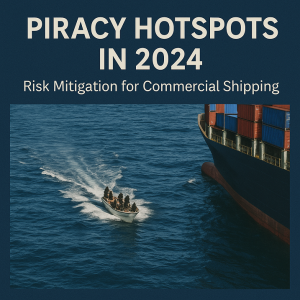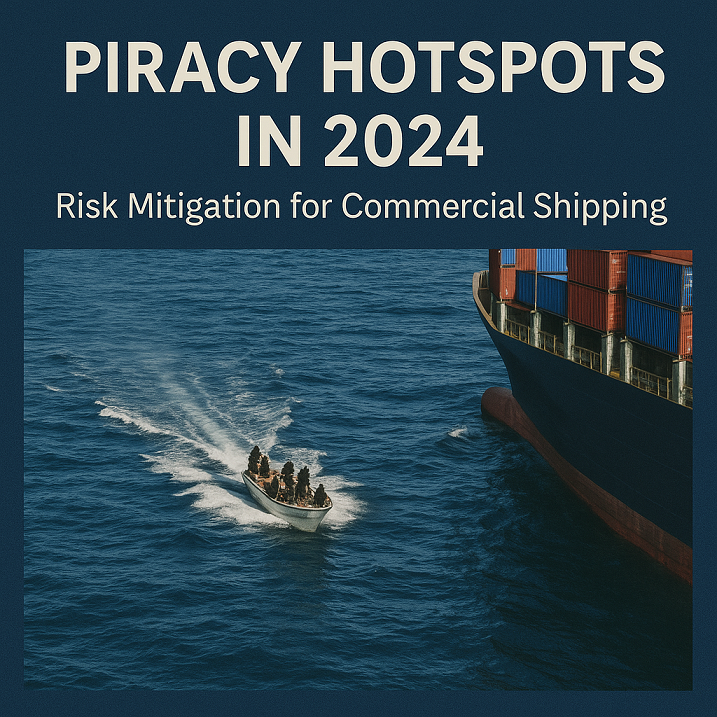Explore the global piracy hotspots of 2024 and discover essential risk mitigation strategies for commercial shipping. Stay informed on evolving threats, modern anti-piracy technologies, and best practices for vessel protection.
Navigating Through Risk in High-Seas Commerce
Despite advances in global maritime security, piracy remains a persistent threat to commercial shipping in 2024. Modern pirates are increasingly organized, better armed, and technologically adept, targeting vulnerable vessels along strategic trade corridors. While high-profile attacks have decreased in some regions, others have seen alarming resurgences.
In today’s interconnected shipping economy, a single piracy incident can cost shipowners millions in ransom, cargo losses, and insurance premiums—not to mention the human toll on seafarers. According to the International Maritime Bureau (IMB), there were over 120 reported incidents globally in 2023, with new patterns emerging in the Red Sea, West Africa, and Southeast Asia.
This article highlights current piracy hotspots, analyzes their operational challenges, and outlines practical, regulation-compliant mitigation strategies for shipowners, operators, and crews navigating these dangerous waters.
Why Piracy Threats Still Matter in Modern Maritime Operations
Piracy is more than just hijackings—it includes armed robbery, kidnappings, and onboard theft, often carried out in territorial waters or congested sea lanes. While IMO conventions like SOLAS Chapter XI-2 and the ISPS Code have enhanced vessel security, many commercial ships—especially smaller or under-crewed ones—remain soft targets.
Modern piracy is driven by:
-
Economic hardship and political instability
-
Weak coastal surveillance or law enforcement
-
High-value, slow-moving maritime traffic
-
Opportunity gaps in chokepoints and anchorages
Beyond immediate losses, piracy affects global supply chains, raises insurance costs (especially war risk premiums), and erodes seafarer morale and retention.

In-Depth Analysis: Piracy Hotspots in 2024
1. Gulf of Guinea – West Africa
Countries Affected: Nigeria, Ghana, Togo, Benin, Equatorial Guinea
Notable Trends:
-
Kidnapping-for-ransom operations remain a major threat
-
Pirates operating up to 200 nm offshore
-
Use of motherships and satellite tracking
Case Study: In February 2024, the oil tanker MV Liberty Dawn was attacked 100 nm off Nigeria. Five crew members were kidnapped and later released after ransom negotiations.
Mitigation Tactics:
-
Coordination with MDAT-GoG (Maritime Domain Awareness for Trade – Gulf of Guinea)
-
Armed guards onboard (allowed in territorial waters with clearance)
-
Participation in Gulf of Guinea Maritime Collaboration Forum
2. Somali Basin & Red Sea
Countries Affected: Somalia, Yemen, Eritrea
Notable Trends:
-
Resurgence of piracy due to maritime threats and regional instability
-
Drone and missile attacks near Bab el-Mandeb Strait
Case Study: In late 2023, the container ship MV Aden Trader was forced to reroute following multiple piracy alerts and drone sightings near the Bab el-Mandeb Strait.
Mitigation Tactics:
-
Adherence to BMP5 (Best Management Practices)
-
Naval coordination via Combined Maritime Forces (CMF) and EU NAVFOR (Operation Atalanta)
-
Speed adjustments and transit timing to avoid night crossings
3. Singapore Strait – Southeast Asia
Countries Affected: Indonesia, Malaysia, Singapore
Notable Trends:
-
Armed robbery at anchor or during low-speed navigation
-
High-frequency incidents with low ransom rates
-
Typically non-violent, targeting valuables and ship stores
Data: According to ReCAAP ISC, 84 incidents were reported in 2023, with 90% occurring during hours of darkness.
Mitigation Tactics:
-
Enhanced onboard lighting and CCTV systems
-
Bridge watch reinforcement during anchorages
-
Participation in Voluntary Community Reporting (VCR) scheme
4. South China Sea
Countries Affected: Philippines, Vietnam, Malaysia
Notable Trends:
-
Overlap with smuggling and maritime terrorism
-
Use of small fast boats in piracy or boarding attempts
-
Disputed waters complicate naval responses
Case Study: In 2023, the MT Valor Rising was boarded off Palawan. While no injuries occurred, the theft of navigation equipment caused significant delays and regulatory entanglements.
Mitigation Tactics:
-
Secure bridge and engine room access points
-
Use of anti-boarding nets and razor wire
-
AIS blackout or delay as advised in BMP guidelines
5. Caribbean & Central America (Emerging Hotspot)
Countries Affected: Venezuela, Honduras, Haiti
Notable Trends:
-
Rise in opportunistic piracy and cargo theft
-
Risk highest near unsecured ports and anchorages
-
Limited state enforcement
Though not as prevalent as in Africa or Asia, emerging piracy in the Caribbean demands vigilance—especially for yachts, small freighters, and supply vessels.
–
Risk Mitigation: Best Practices and Emerging Solutions
Regulatory Compliance
- SOLAS Chapter XI-2: Requires Ship Security Plans (SSP) and Designated Security Officers
- ISPS Code: Mandates vessel-specific security levels and protocols
- IMO MSC.1/Circ.1334: Offers guidance on piracy countermeasures
Physical Measures
- Barriers: Razor wire, electric fencing, water cannons
- Safe Rooms (Citadels): Reinforced compartments with satellite communication and life-support
- Watchkeeping: 24/7 bridge manning and radar surveillance
Crew Training & Drills
- Security Awareness Training as per STCW VI/6
- Drills for lockdown, distress signaling, and evasive maneuvers
- Mental health support for post-incident recovery
Technological Aids
- Long-Range Acoustic Devices (LRADs)
- Maritime Security Drones
- Inmarsat Fleet Secure for cybersecurity and vessel tracking
- AIS Spoofing Detection Tools to counter false positioning tactics
–
Real-World Lessons: Strategic and Tactical Outcomes
Following the 2021 Ever Given incident, Egypt accelerated modernization of the Suez Canal Authority’s security division, integrating drone surveillance and rapid response teams. Similarly, in the Gulf of Guinea, collaboration between shipping companies and Naval Task Force 150 led to reduced incidents in 2023.
However, gaps remain. In 2024, a bulk carrier off Benin operated without updated security protocols and became an easy target. This underscores the need for not just technology, but crew compliance and awareness.
–
Frequently Asked Questions (FAQ)
Are pirate attacks decreasing globally in 2024?
Yes, slightly. But attacks in specific hotspots like West Africa and the Red Sea have increased due to regional instability.
Is piracy covered under marine insurance?
Yes, through War Risk Insurance or Kidnap & Ransom (K&R) policies. Rates vary based on the vessel’s route and cargo.
Can ships carry armed guards?
Yes, in some regions. Flag state and port state laws must be considered. Armed guards are common in the Indian Ocean but restricted in Southeast Asia.
What is BMP5?
Best Management Practices version 5—a guide developed by the IMO, ICS, BIMCO, and others for ship protection in high-risk areas.
What are citadels?
Reinforced onboard rooms where crew can lock themselves in and communicate with naval forces until rescue.
–
Conclusion: Securing the Lifelines of Global Trade
Piracy in 2024 is no longer a relic of the past—it’s a dynamic, evolving threat that exploits political instability, technological gaps, and human complacency. As shipping lanes grow busier and geopolitical landscapes shift, proactive maritime security is not optional—it is a legal, operational, and ethical imperative.
By combining regulatory compliance, crew readiness, technological investment, and naval coordination, shipowners can safeguard lives, cargo, and capital. The future of safe shipping depends on informed vigilance—starting at the bridge and supported across the entire supply chain.

